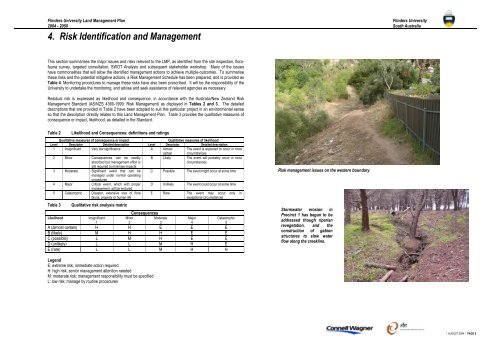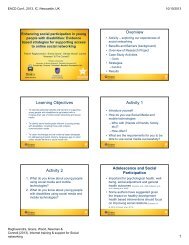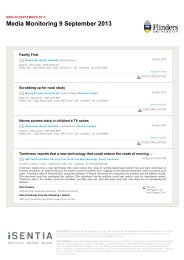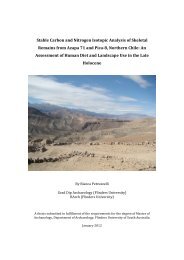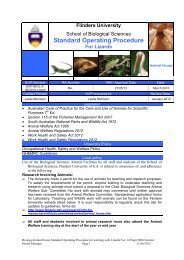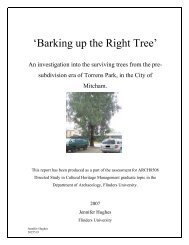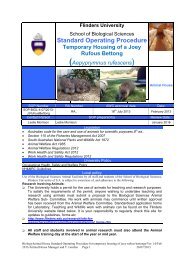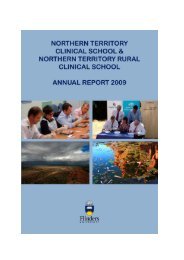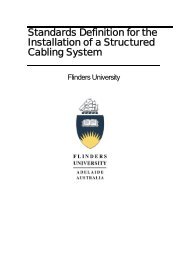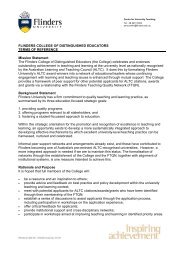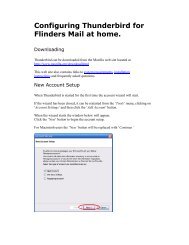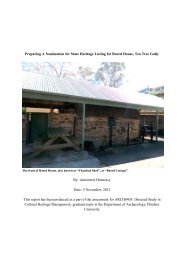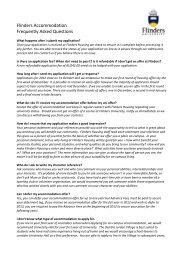Land Management Plan 2004 - 2050 Flinders University South ...
Land Management Plan 2004 - 2050 Flinders University South ...
Land Management Plan 2004 - 2050 Flinders University South ...
You also want an ePaper? Increase the reach of your titles
YUMPU automatically turns print PDFs into web optimized ePapers that Google loves.
<strong>Flinders</strong> <strong>University</strong> <strong>Land</strong> <strong>Management</strong> <strong>Plan</strong> <strong>Flinders</strong> <strong>University</strong><br />
<strong>2004</strong> - <strong>2050</strong> <strong>South</strong> Australia<br />
4. Risk Identification and <strong>Management</strong><br />
This section summarises the major issues and risks relevant to the LMP, as identified from the site inspection, florafauna<br />
survey, targeted consultation, SWOT Analysis and subsequent stakeholder workshop. Many of the issues<br />
have commonalities that will allow the identified management actions to achieve multiple-outcomes. To summarise<br />
these risks and the potential mitigative actions, a Risk <strong>Management</strong> Schedule has been prepared, and is provided as<br />
Table 4. Monitoring procedures to manage these risks have also been prescribed. It will be the responsibility of the<br />
<strong>University</strong> to undertake the monitoring, and advise and seek assistance of relevant agencies as necessary.<br />
Residual risk is expressed as likelihood and consequence, in accordance with the Australia/New Zealand Risk<br />
<strong>Management</strong> Standard (AS/NZS 4360-1999: Risk <strong>Management</strong>) as displayed in Tables 2 and 3. The detailed<br />
descriptions that are provided in Table 2 have been adapted to suit this particular project in an environmental sense<br />
so that the description directly relates to this <strong>Land</strong> <strong>Management</strong> <strong>Plan</strong>. Table 3 provides the qualitative measures of<br />
consequence or impact, likelihood, as detailed in the Standard.<br />
Table 2<br />
Likelihood and Consequences: definitions and ratings<br />
Qualitative measures of consequence or impact<br />
Qualitative measures of likelihood<br />
Level Descriptor Detailed description Level Descriptor Detailed description<br />
1 Insignificant Very low significance A Almost<br />
certain<br />
The event is expected to occur in most<br />
circumstances<br />
2 Minor Consequences can be readily B Likely The event will probably occur in most<br />
absorbed but management effort is<br />
circumstances<br />
still required to minimise impacts<br />
3 Moderate Significant event that can be C Possible The event might occur at some time<br />
managed under normal operating<br />
procedures<br />
4 Major Critical event, which with proper D Unlikely The event could occur at some time<br />
management, will be endured<br />
5 Catastrophic Disaster, extensive loss of flora<br />
fauna, property or human life<br />
Table 3<br />
Likelihood<br />
Qualitative risk analysis matrix<br />
Insignificant<br />
1<br />
Minor<br />
2<br />
Consequences<br />
E Rare The event may occur only in<br />
exceptional circumstances<br />
Moderate<br />
3<br />
Major<br />
4<br />
Catastrophic<br />
5<br />
A (almost certain) H H E E E<br />
B (likely) M H H E E<br />
C (possible) L M H E E<br />
D (unlikely) L L M H E<br />
E (rare) L L M H H<br />
Risk management issues on the western boundary<br />
Stormwater erosion in<br />
Precinct 1 has begun to be<br />
addressed though riparian<br />
revegetation, and the<br />
construction of gabion<br />
structures to slow water<br />
flow along the creekline.<br />
Legend<br />
E: extreme risk; immediate action required<br />
H: high risk; senior management attention needed<br />
M: moderate risk; management responsibility must be specified<br />
L: low risk; manage by routine procedures<br />
⏐ AUGUST <strong>2004</strong> ⏐ PAGE 6


